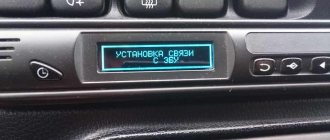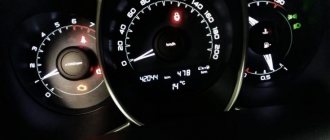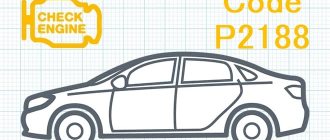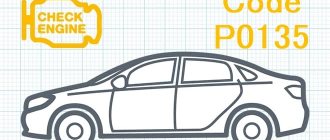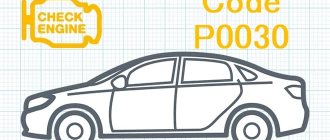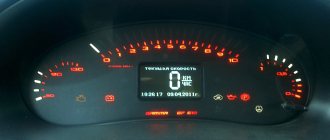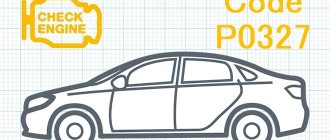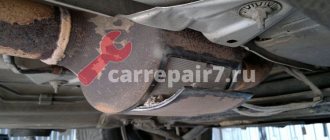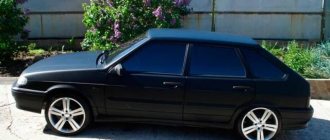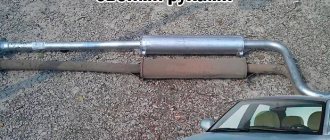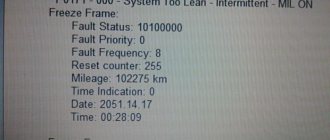Technical description and interpretation of error P0422
This diagnostic trouble code (DTC) is a generic powertrain code. The P0422 code is considered a common code because it applies to all makes and models of vehicles. Although the specific repair steps may vary slightly depending on the model.
A car's catalytic converter (catalyst) helps reduce exhaust emissions by saturating them with oxygen. It helps convert hydrocarbons (HC), carbon monoxide (CO) and oxides of nitrogen (NOx) into water vapor (H₂O), carbon dioxide (CO₂) and nitrogen (N).
The PCM (powertrain control module) monitors catalyst efficiency using a post-catalyst oxygen sensor. This sensor is primarily used for this purpose. It should shift much slower than the front oxygen sensors.
If at any time the PCM detects that the downstream O₂ sensor is switching too quickly (indicating there is no change between the catalytic converter input and output). It recognizes this as a catalytic converter that is not working properly and displays a P0422 OBD2 error code.
Conditions for generating DTC P0420
The ECM, in the process of monitoring, compares the signals of the 1st and 2nd sensors during a given time interval, calculating the duration of the voltage signal, and if it goes beyond a given threshold, the “brain” of the car interprets this as a malfunction of the neutralizer. The threshold value of the difference between the amplitudes of the front S1 (taken as the standard) and rear S2 oxygen sensors is more than 0.7 times per minute. But the check light, indicating that an error has been recorded in the memory of the ECM unit, does not light up instantly, but only when a decrease in the performance characteristics of the catalytic converter occurs for 100 seconds, and the engine load should be from 21 to 63% when the crankshaft rotates 1,720 - 2,800 rpm, and the catalyst temperature exceeds 500 degrees.
Signal from oxygen sensor
During normal operation of the catalytic converter, the downstream heated oxygen sensor signal switches slowly between rich and lean conditions. Frequent switching of the lambda probe between these states indicates a decrease in the efficiency of the converter. As a result, its ability to accumulate oxygen is reduced.
The task of the catalyst is to oxidize carbon monoxide and neutralize CO2 hydrocarbon emissions in order to reduce the concentration of harmful substances. This process, starting with the Euro 3 standard, is monitored by two oxygen sensors. There is a constant comparison of the signals of the first and second lambda in order to register the convergence of their readings. Therefore, error code P0420, in due time, will bother all owners of cars, including VAZ, Nissan, Toyota, Chevrolet, Ford, Honda or others produced after 1996 and having 2 lambda probes in the exhaust system.
Trouble code P0420 appears when oxygen and unburnt fuel residues are detected in the exhaust gases.
Symptoms of malfunction
The main driver symptom of P0422 is the MIL (Malfunction Indicator Light) illumination. It is also called Check engine or simply “check light”.
They can also appear as:
- The “Check engine” warning light on the control panel will light up (the code will be stored in the ECM memory as a malfunction).
- The engine stalls or has trouble starting.
- Decrease in engine power.
- Increased emissions of harmful substances from the exhaust pipe.
Reasons for the error
A P0422 code may mean that one or more of the following problems have occurred:
- Bad or non-functional catalyst.
- Oxygen sensor malfunction.
- The engine is running without the optimal air/fuel ratio.
- The engine coolant temperature sensor has failed.
- Leak in the engine before the catalytic converter.
- Misfires in engine cylinders.
- Damage to wires and connectors.
- Problems with the manifold air pressure sensor.
- Contamination of the engine oil due to non-regular replacement.
- The air flow sensor has failed.
- Malfunction of the fuel pressure regulator.
What does it indicate?
The occurrence of error P0420 makes it clear to the car owner that not everything is in order with the operation of the catalyst and it is not able to cope with the entire volume of incoming exhaust gases. However, this does not always mean that the catalyst has failed. It is likely that it became clogged and this, in turn, negatively affected the throughput.
It is important to note that if there are two neutralizers on one car, this error code is P0430. This is typical for vehicles of Euro 3 standard from above.
How to Troubleshoot or Reset Trouble Code P0422
Some suggested steps to troubleshoot and fix error code P0422:
- Inspect the sensor wires located near the catalyst.
- Check the oxygen sensors.
- Repair engine leaks.
- Test the air flow sensor as well as the manifold air pressure.
- Check the fuel pressure regulator.
- Test the engine coolant temperature sensor.
- If no problems are found, check the catalytic converter and replace it if necessary.
Diagnosis and problem solving
Error P0422 can be diagnosed using a standard OBD-II scanner. Use the scanner to view data and collect information about the code. And also to check for other error codes that may be present.
Next, clear the error codes from the PCM memory and retest the system to see if P0422 appears again. If the code disappears, it may indicate an intermittent error or that the code appeared in error.
If the P0422 code occurs again, inspect the wires and connectors near the catalytic converter. Repair or replace any damaged items. After this, inspect the catalytic converter and also perform a thorough check of the exhaust system for leaks.
If the problem is the catalytic converter, replace it. Also inspect other vehicle components to determine the cause of the catalytic converter damage.
Test methods and problem solving
In some cases, it is necessary to check the serviceability of the oxygen sensor or the exhaust system and manifold for leaks. Leaks and leaks can affect the operation of the O2 sensors and cause the P0420 error code to appear, but still, more often this problem is directly related only to the condition of the catalyst.
Some tips for a troubleshooting plan
Before starting diagnostics, in order to save time on finding out the cause and fixing the problem, we advise you to carry out a few simple checks, and then proceed to further, complex solutions to the problem. So:
Checking the operation of the catalytic converter and its parameters
To assess the efficiency of the catalyst, it is necessary to compare the output voltage graphs between the “upper” and “lower” oxygen sensors, as well as look at the fuel supply adjustment data.
Oxygen sensor readings on an oscilloscope
The output voltage of the oxygen sensor, read by the car's computer, will decrease when the mixture is lean and increase when it is rich. A normal reading for an oxygen sensor will fluctuate between 900 millivolts (rich condition) and 100 millivolts (lean condition).
Short-term adjustment, ideally, should tend to “0”, but on an engine with mileage, deviations from the norm of up to 10% are acceptable. And when the fuel adjustment exceeds 25%, then a long-term adjustment also occurs, so if both values are present, this indicates a problem in preparing the fuel-air mixture. Therefore, pay attention to the presence of additional fault codes.
How to troubleshoot P0420
Some car owners, unaware of the origin of the P0420 error, may begin to eliminate the problem by cleaning the damper or replacing sensors that affect air and fuel consumption. While, if you need to try to replace something, it’s this:
Firstly, swap lambda probes , upper and lower, since they are the same and can replace each other. Therefore, if the problem is precisely the non-working second oxygen sensor, then the error code will change (alternatively, error P0134 may appear).
Secondly, fill up with other gasoline , of better quality, and drive a little (if it’s because of the fuel, then a couple of days will change the situation).
The third step towards troubleshooting can be checking the catalyst , or rather, its throughput (there are several methods). Internal catalyst failure usually occurs due to abnormal operation of the engine systems upstream of the catalyst. An increased operating temperature of the converter is usually the cause of both the appearance of this code and its failure. For example, misfires can lead to elevated catalyst operating temperatures.
On which cars is this problem most common?
The problem with code P0422 can occur on different machines, but there are always statistics on which brands this error occurs more often. Here is a list of some of them:
- Audi
- Chevrolet
- Chrysler
- Dodge (Dodge Caravan)
- Ford
- Hyundai (Hyundai Accent, Elantra)
- Kia (Kia Spectra, Sportage)
- Mercedes
- Mitsubishi
- Peugeot (Peugeot 206)
- Volkswagen (Volkswagen Beatle, Jetta)
- Volvo
- VAZ 2104, 2105, 2107, 2110, 2111, 2112, 2113, 2114, 2115
- Volga Chrysler, 31105
- Gazelle Business, Next
- Lada Vesta, Granta, Kalina, Niva, Priora
- UAZ
With fault code P0422, you can sometimes encounter other errors. The most common are the following: P0304, P0326, P0420, P0441, P0455.
Buy a minibus and drop it off. The error only appears on the highway. When the error pops up that the second dk is dead, then replace it with a bosch.
According to readings on the forums, the problem often occurs not in the first gases. There seems to be a firmware update out now, but it’s lazy to go crazy over such a trifle.
The action plan is approximately this: You can try to swap the DCs and see what happens. VAZ supplies Delphi cultural centers, which are not of high quality.
In general, there are certain instructions in this regard:
Error 0422 – Neutralizer efficiency below threshold The error is entered under the following conditions: 1. there are no errors 0102, 0112, 0113, 0116, 0117, 0118, 0122, 0123, 0130, 0132, 0134, 0136, 0137, 0138, 0140, 0171, 0172 , 0300, 03**, 0441, 0444, 0445, 0562, 0563. 2. The ECU controls the fuel supply in a closed loop Parameter (B_LR= “YES”). 3. The conditions for the ECU to carry out the catalyst diagnostic cycle have been met. 4. The ECU has determined that the oxygen content after the neutralizer is above the threshold. The error is entered into the ECU memory on the third drive cycle. The efficiency of the neutralizer can be assessed using the ANKAT parameter (neutralizer efficiency factor). If the ANKAT value tends to zero, the neutralizer is working effectively. The larger the ANKAT value, the more the neutralizer degrades. Check procedure: 1. Turn off the ignition, connect the diagnostic tool, turn on the ignition, check for errors. If there are other errors in the ECU memory, we eliminate them first. 2. If there is an error, inspect the catalytic collector for damage, check the condition of the “filling”. 3. If malfunctions are found, replace the catalytic collector; if there are no comments, check the exhaust system between the neutralizer and the main muffler for leaks, incompleteness, or damage. Make sure that there is no damage to the DDC and that the wiring harness is not damaged. If no faults are found, replace the neutralizer. 4. If faults are found, fix them. Start the engine, warm it up to a coolant temperature of 70 degrees. Set the rotation speed of the HF to 2000 - 3000 rpm for at least 4 minutes. The load on the engine should have a stable value of 15 - 50%. If the error does not appear, the malfunction has been eliminated; if the error appears again, replace the neutralizer.
2 years ago AutoTime 0
Trouble code P0422 is a standard OBD-II trouble code. Code P0422 indicates that the efficiency of the main catalyst is below acceptable levels. Catalyst efficiency is determined by the engine control module, which uses exhaust gas and temperature data from both the upstream and downstream oxygen sensors to determine catalyst efficiency. If the sensor readings at the input and output are too similar, then the efficiency of the catalyst will most likely be below the acceptable level and the control unit will record error P0422.
The efficiency of the main neutralizer block 1 is below the threshold
From the moment I bought the car, literally in the first thousand kilometers, I began to be haunted by one single error “P0422 Converter efficiency below the threshold”, it is periodically registered in the ECU and not long after that it pops up on the instrument panel “CHECK”. I’ll immediately erase the staff and continue riding, approximately between “CHECKS” the mileage is around 400 - 500 km. It looks like it still sits from the manufacturer's factory. It’s as if my upbringing tells me that this is a mistake and needs to be corrected. What has already been double-checked a hundred times:
1) The spark plugs are all new, 3 sets just for fun and nothing changes, there is no plaque on them, the gaps are clear, the insulators are intact. 2) The wires to the armor were tested for both integrity and resistance, I tried to test it from a working machine and there was no difference. 3) The coil was removed and checked, I also used Kalina 2 and the result was the same. 4) The fuel rail with injectors was removed and tested in a bench, the spray was excellent, the same, just in case I washed it, in one flask, unlike the other three, it was a fraction of a millimeter smaller than in the others, but the flask was 15 centimeters and half a millimeter, just a miracle result. 5) The filters are all new, I change them along with the oil every 6-7 thousand km. 6) The timing and timing gear marks are all clear. 7) The clearances in the gas distribution mechanism are excellent, they were recently rechecked. I’ve already forgotten the specific compression number, but this is what I remember, it’s the same in all cylinders, everything is clear and not low. 9) The pressure in the fuel rail was checked, everything seems to be normal, I checked it two years ago. I can’t say for sure now. 10) The sensors were not touched at all. 11) Gasoline is used only by G95, and by the way, I noticed a tendency that the “CHECK” usually pops up 300-400 meters after refueling.
What are the symptoms and abnormalities:
1) The non-original ECU was changed right during pre-sale preparation in the showroom with the same only blue standard Granta 2) From the sound in the video you can hear that there is a certain misfire, as if one cylinder is out of tune, a small misfire is a barely audible pop 3) Engine speed at idle are not stable and wander a little around 90-100 rpm. min. Well, something like this. I'm waiting for advice! Give up another year with this sore, or still suffer.
VAZ fuel-injected cars have a special engine control and diagnostic system called an ECU (electronic control unit). With its help, you can get acquainted with malfunctions that arose during the operation of the car. VAZ 2110, 2114, 2115 cars and the procedure for eliminating them.
Causes of error P0422
The most common cause of the P0422 code is a faulty catalytic converter. However, there are many other problems that can cause the catalytic converter to malfunction (or may cause it to fail), including the following:
- faulty oxygen sensor
- Coolant temperature sensor malfunction
- faulty fuel pressure regulator
- Malfunction of the manifold air pressure sensor
- malfunction of the mass air flow sensor
- contaminated motor oil
- leakage of the exhaust system in front of the catalyst.
- incorrect engine operation
- damaged wiring or connectors.
Online consultation
A three-way catalytic converter is used to control the exhaust emissions of hydrocarbons (HC), carbon monoxide (CO), and nitrogen oxide (NOx). The catalyst in the converter accelerates the chemical reaction of oxidation of HC and CO in the exhaust gas, turning them into harmless vapors of water and carbon dioxide. It also reduces NOx by converting it to nitrogen. The catalytic converter can also store oxygen. The ECM can monitor this process using the heated oxygen sensor (HO2S2), located in the exhaust stream after the catalytic converter. The HO2S2 sensor produces a signal that indicates the amount of oxygen catalyst, which in turn indicates the ability to effectively neutralize exhaust emissions. The ECM monitors the performance of the converter by allowing it to warm up first, allowing it to cool down while the engine is idling, and then increasing or eliminating excess fuel by monitoring the response of the HO2S2 sensor. During normal operation of the converter, the response of the HO2S2 sensor to an excessive fuel content is sequentially compared with the HO2S1 sensor. If the response of the HO2S2 sensor is similar in level to the response of the HO2S1 sensor, then the amount of oxygen catalyst or the performance of the converter is perceived as insufficient and the malfunction indicator lamp (MIL) lights up. Conditions for Setting the DTC The vehicle is operating in closed loop mode. Engine coolant temperature (ECT) is above 78°C (172.4°F). Mass air flow ranges from 15 to 30 kg/hour. Engine speed ranges from 1792 to 2304 rpm. Vehicle speed ranges from 45 km/h to 56 km/h. The deviation in air flow is less than 10 kg/hour. Predicted catalytic converter temperatures range from 300°C (572°F) to 800°C (1472°F). The engine runs for more than 60 seconds. There are no DTCs related to the HO2S sensor, misfire, coolant temperature sensor, crankshaft position sensor, camshaft position sensor, vehicle speed sensor, manifold air temperature sensor, throttle position sensor, IAC actuator, EGR valve, fuel trim or CAN bus communication. Conditions for setting the DTC. The HO2S2 filter signal value is greater than 101. Action Taken When the DTC Sets The malfunction indicator lamp illuminates. The controller records the operating conditions at the time the fault is detected. This information is stored in a status record buffer and fault logs. An archive of diagnostic trouble codes is saved. Conditions for Clearing the DTC/Malfunction Indicator The DIL turns off after three consecutive test cycles have completed without failure. The historical DTC clears after 40 heat cycles without failure. The DTC can be cleared by a scan tool. Diagnostic Aids The converter test may stop due to changes in engine load. While checking the converter, do not change the engine load (ie battery, cooling fan, heater motor). An intermittent malfunction can be caused by a weak connection, frayed insulation, or broken wiring in the insulation. Any circuit that may be causing an intermittent fault should be carefully inspected for the following: Removed terminals Terminal connections Faulty locks Warped Damaged terminals Loose connections between terminals and wires.
Diagnosis of error P0422
Diagnosis of error P0422 is carried out using an OBD-II fault code scanner. First you need to read the stored error codes. After this, clear all saved errors and start the car. If no error is returned, then most likely there is no problem.
If the error returns, you need to inspect the wiring and connectors of the oxygen sensors. If there is a problem, it must be fixed, and the error codes must be reset to make sure that there are no errors. After wiring, you need to inspect the catalyst itself and the exhaust system.
If problems are detected with the catalyst, you need to find out the cause of its damage, which is usually the result of a malfunction elsewhere in the engine.
Vehicle diagnostics and troubleshooting
If you nevertheless decide to buy a used car, then you should definitely make a diagnosis, paying attention to any Lada error codes that appear on the device display. Information about existing errors will be very useful, be sure to pay special attention to this
To diagnose and find out information, you should contact a car service center if there is no special insert on the used car you are buying.
In fact, such a procedure is a huge list of information that can tell about any possible danger. Usually this is not given importance, but in vain. For example, if a car’s BC states that the airbags are faulty, you definitely need to check this. Correction: what needs to be done? Immediately press the left button and the right one, from this press the on-board computer adjusts the selected parameter.
Then pressing the keys left or right changes the parameters. After pressing simultaneously, you exit from the adjustment. Reset. By pressing the left and right keys simultaneously, the options displayed on the screen will be reset. If everything is done in the “System error” mode, after that the error disappears. If faults actually exist, the error will remain in memory until reset occurs.
If the BC does not turn on, the causes of the problem are:
- there is no electric current in the BC connectors;
- there is no contact in the terminals.
BC cannot diagnose the reasons for this:
- the wire came loose;
- no contact.
BC cannot calculate the speed of the car, the reasons for this problem are:
there is no contact in the connectors.
BC cannot calculate the remainder in the fuel tank, reasons:
devices do not have software compliance.
The BC incorrectly shows how much fuel is left in the tank, the reasons for this are:
- there is no wire in the wiring at the 8th contact and the 9th terminal in the on-board computer;
- The car panel is showing incorrectly.
There is no BC screen backlight, reasons:
I need to make the screen brighter.
The thermometer shows incorrectly, reasons:
- the wire has broken in the temperature detection sensor;
- incorrect contact with the on-board computer.
No voice accompaniment, reasons:
- speaker is faulty;
- the software has crashed;
- The voice accompaniment is not reproduced (you must press the “up” key and hold it for more than three seconds).
BC writes incorrectly, the program has gone wrong, etc., reasons:
- The on-board computer is not connected or there is no contact with it;
- there is no contact in the connected battery terminal (the contact should be securely fixed).
Initialize the BC:
- previous settings will be reset;
- reset all parameters for the previous ride;
- set the clock to 8 hours 00 minutes;
- The alarm clock should be at zero, its notification is disabled.
What does P0422 mean?
Trouble P0422 is a general trouble code that indicates that the primary catalytic converter (bank 1) efficiency is below acceptable levels. Catalyst efficiency is determined by the transmission control module (PCM), which uses exhaust gas and temperature data from oxygen sensors located upstream and downstream of the catalytic converter to determine efficiency. If the readings from both sensors match or are almost identical, this indicates that the catalyst efficiency is most likely below acceptable levels. In this case, error P0422 will appear.
What does Bank 1, Bank 2 mean?
The designation Bank 1 and Bank 2 is usually used if the vehicle has more than four cylinders. But it is also used on four-cylinder engines.
This means that you probably have two exhaust pipes or that the engine cylinders are split into multiple O2 sensors. “Bank” indicates which side or exhaust pipe the sensor is located on.
Bank 1 is always installed on cylinders 1-3-5-7-9, etc. Bank 2 sensor monitors cylinders 2-4-6-8-10.
You can disable one oxygen sensor and read errors with the OBD2 scanner. This will allow you to find out where the sensor is installed - in Bank 1 or Bank 2.
Causes of error P0422
The most common cause of P0422 is a faulty catalytic converter. Other reasons are:
- Oxygen sensor malfunction
- Engine coolant temperature sensor malfunction
- Fuel pressure regulator malfunction
- Manifold air pressure sensor malfunction
- Air flow sensor malfunction
- Engine oil contamination
- Engine leak before catalytic converter
- Misfires in engine cylinders
- Damage to wires and connectors
How does a mechanic diagnose a P0422 code?
Error P0422 can be diagnosed using a standard OBD-II scanner. The mechanic uses a scanner to view data and gather information about the code, as well as check for other error codes that may be present. The mechanic will then clear the error codes from the PCM memory and retest the system to see if P0422 appears again. If the code disappears, it may indicate an intermittent error or that the code appeared in error.
If the P0422 code appears again, have a mechanic inspect the wires and connectors near the catalytic converter. He will repair or replace any damaged items. The mechanic will then inspect the catalytic converter and also perform a thorough check of the exhaust system for leaks.
If the catalytic converter is the problem, the mechanic will examine other vehicle components to determine the cause of the catalytic converter damage.
Common errors when diagnosing code P0422
The most common mistake when diagnosing a P0422 code is failure to follow the diagnostic protocol, which leads to hasty replacement of the catalytic converter. Before replacing the catalyst, it is necessary to eliminate the cause of its damage, and also consider other error codes present.
It is also a mistake to hastily replace oxygen sensors. Before replacing them, it is necessary to perform a thorough diagnosis, since usually a faulty sensor is not the only cause of the P0422 error.
How is self-diagnosis performed?
We have sorted out the main errors on the Priora, now it’s worth finding out how self-diagnosis is performed. The VAZ 2170 with 16 valves has a special controller with which diagnostics are performed. If you have an on-board computer installed, then diagnostics are performed on it. There is also special equipment that allows for a more in-depth check of Priora 16 class systems.
Since most Priora 16 cars already have an on-board computer, we will consider the option without the use of special devices. Diagnostics begins with activation of the test mode. The work proceeds according to the following scheme:
How serious is the P0422 code?
The severity of the P0422 code depends on the cause of its occurrence. If the problem is a bad catalytic converter, the engine may stall frequently or be difficult to start. In this case, problems with the vehicle's handling may occur. However, if everything is in order with the catalyst, there should not be any serious problems. In any case, if this code is detected, it is recommended that you contact a qualified technician as soon as possible to diagnose and repair the error to avoid serious damage to the catalytic converter.
To resolve error P0422 you may need to:
- Replacing the catalytic converter
- Replacing oxygen sensors
- Repair or replacement of electrical wires and connectors
- Repairing engine leaks
- Replacing the air flow sensor
- Replacing the manifold air pressure sensor
- Replacing the fuel pressure regulator
- Replacing the engine coolant temperature sensor
Additional comments for troubleshooting P0422
If the cause of this error is a faulty oxygen sensor, other error codes related to this sensor may also appear along with the P0422 code.
Car manufacturers are required to provide a 100,000 kilometer warranty on the catalytic converter. If the catalyst is damaged or fails, you need to find out whether it can be replaced under warranty.
Need help with error code P0422?
The company - CarChek, offers a service - on-site computer diagnostics; specialists from our company will come to your home or office to diagnose and identify problems with your car. Find out the cost and sign up for on-site computer diagnostics or contact a consultant by phone
The last time this error occurred was after refueling. BUT! I've been filling up at this gas station my entire car life! The name of this gas station is Gazprom! AI-95!
Tell me, is it still because of the gasoline? Or what other common reasons are there? How did anyone deal with this problem?
In advance, very grateful for your answer!
How to solve the problem of low catalyst efficiency
Since most often the P0420 error appears when the catalyst has expired, most likely the problem of low efficiency of the catalytic converter system below the threshold level will have to be solved by replacing it with a working one or flashing the ECM to a different toxicity standard (under EURO2).
The most expensive (about 40,000 rubles) repair method will be replacing the catalyst with a new original one.
Much cheaper (5-6 thousand rubles) - replace it with a universal catalyst. Its operating efficiency is somewhat worse (the original is ceramic, while this one is often made of iron), the service life is only about 30-50 thousand km, and not all cars will react positively to such a change. But you won't have to make any software changes. It will cost about the same to buy a used original from disassembly.
When toxicity standards are not important to you, installing a flame arrester is a relatively inexpensive option. This solution involves cutting out the catalyst can and installing a second lambda blende.
A budget option, including re-flashing and installation of a blende (mechanical or electronic), is a transfer of the car to a lower toxicity standard. Such a solution to the problems that appeared with code p0420 will not only eliminate the malfunction, but also allow the engine to “breathe deeply,” because all these standards greatly reduce power capabilities in order to comply with environmental standards. This method involves removing the catalyst from the exhaust system, and installing a two-channel emulator will make it possible to fine-tune the response time parameters, signal speed and its offset.
And if the throughput of the catalytic converter is still within the normal range (0.21 kg/cm² at 2000 rpm), since a signal about the need to replace the catalyst can appear even at 70% efficiency, then you can temporarily install a spacer under the lambda probe. This solution is the cheapest, but not a panacea and is not suitable for everyone.
I hope that all the above methods for solving the problem associated with code P0420 will help you, and you will no longer have questions like: “why did error P0420 appear and how to fix it,” and you will share the knowledge gained on social networks with your friends. Write us a review, whether you managed to fix the problem, how much it cost, and which method helped to figure out the reason for the poor efficiency of the catalyst.
Catalyst performance too low
Decoding OBD-2 error p0422
Error p0422 appears in the controller logs when it detects low catalyst efficiency. The catalyst is installed in the exhaust system and acts as a filter, purifying exhaust gases from harmful substances. But they all accumulate in it and over time the neutralizer becomes clogged, and the second oxygen sensor monitors its condition.
A neutralizer is needed solely to improve the environmental class of cars, many people get rid of it, after this procedure they need to install a lambda probe blende or flash the ECU. Car enthusiasts who have carried out this procedure notice an increase in power and the engine begins to breathe easier.
Sometimes it is very difficult to remove the catalyst and replacing it is a much cheaper and faster option.
Error p0422 indicates that the difference between the readings of the first and second oxygen sensors differs by a value less than the threshold, that is, the catalyst does not perform its functions, retaining soot and other fuel combustion products.
A car with error code p0422 can be used normally, but its presence cannot be tolerated.
Possible symptoms due to error p0422
For the engine, such an error cannot make big changes, but the controller is working with an error and the following changes may appear:
- Increased fuel consumption;
- Exhaust toxicity;
- Power reduction;
- Possible increase in engine volume.
Reasons for registering error code p0422
Some errors may appear as a result of erroneous operation of the brain ECU, and if after removing error p0422, it appears again, you need to pay attention to the following reasons:
- Serviceability of oxygen sensors;
- Catalyst condition;
- Safety of lambda probe wiring;
- Exhaust system integrity.
Error “P0422 Main Catalyst Efficiency Below Threshold (Bank 1)” or “P0422 Main Catalyst Efficiency, Below Threshold)” means “The efficiency of the main catalyst B1 (neutralizer) is below the permissible threshold.” Most likely this is already replacing the catalyst or, as an option, removing it, but the reason may be less significant... oxygen sensor, wiring.
Repair prices vary greatly, because... depend on the reason for the appearance of P0422 in Lada (2104,2105,2107)
